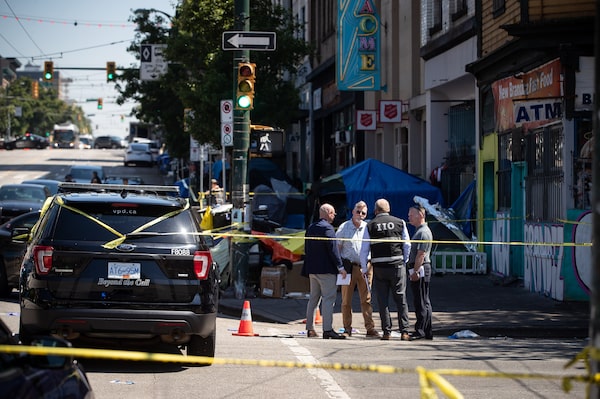
A member of the Independent Investigations Office speaks to other investigators at the scene of a police involved shooting in the Downtown Eastside of Vancouver, on July 30, 2022.DARRYL DYCK/The Canadian Press
Police use of deadly force is rising in Canada despite pledges from political leaders to curb the violence, according to newly released research.
The information was gathered by a group made up of academics and members of advocacy organizations. According to the group’s analysis, which it is publishing on a website called Tracking Injustice, Canadian police officers killed 69 people in 2022, the highest known total in a single year.
The research project, partly funded by a federal grant, aims to keep count of civilians who die during such violent interactions. It includes researchers at Carleton University, Queens University and the University of Toronto. The advocacy organizations involved include the Canadian Civil Liberties Association.
Carleton criminologist Alexander McClelland, who is involved in the project, said police violence has become more pervasive over the past four years. “The rise that we’ve seen, the quite dramatic rise, can’t be easily explained,” he said.
While he said the project’s database of police-involved killings remains a work in progress, he explained that the researchers are putting out their preliminary findings now, in the hope that they will spark debate. The group intends to create a constantly updated online reference tool, he said, which will draw in information from research, reports from provincial government review bodies, media articles and the public.
The Tracking Injustice database does not contain the identities of more than half of the people it lists as having been killed during deadly police interactions in 2022. “For us the ‘unknowns’ are a symbol of the lack of transparency and the lack of publicly available information,” Mr. McClelland said.
Currently, there is no government body in Canada that tracks killings involving police nationwide. “The lack of data prevents researchers, policy-makers, advocates, and communities most impacted by police violence from answering basic questions about police use of force,” the Tracking Injustice researchers said in a statement.
Blow-by-blow accounts of violent interactions involving police are often withheld from the public for months or years, until provincial review bodies issue official reports.
Most of the time, those review bodies clear police of wrongdoing. But in rare cases charges are laid. Early this month, B.C. prosecutors charged two officers with manslaughter in relation to the 2017 death of an Indigenous man. Last year, the Ontario Special Investigations Unit charged three officers with manslaughter after an infant was killed during a police shootout involving a father who was accused of abducting the child.
According to the research group’s preliminary data, there have been more than 700 documented police use-of-force deaths in Canada since 2000. Black and Indigenous people accounted for 27 per cent of those deaths, according to the data, but a lack of race statistics means the real percentage could be much higher. Black people make up 4.3 per cent of Canada’s population, and Indigenous people make up 5 per cent, according to the most recent census.
The group says roughly three-quarters of the fatalities it has documented resulted from police shootings.
Police use-of-force models across North America came under scrutiny three years ago following the May, 2020 death of George Floyd at the hands of Minnesota police. Politicians and police leaders vowed to improve police practices and accountability.
But observers say those changes largely did not come to pass. “Much of what has happened has been largely performative,” said Temitope Oriola, a criminology professor at the University of Alberta who has called for changes to police recruiting, training and use-of-force models.
Law-enforcement leaders have said authorities are grappling with an extraordinary number of crises, including the slayings of five police officers in unprovoked attacks across Canada during the past six months.
“The COVID period has resulted in a number of mental-health challenges, so we’re dealing with a lot more volatile situations,” said Scott Mills, a spokesperson for the Ontario Provincial Police Association.
“Police officers don’t go to work wanting to get in a fight or shoot or kill somebody. Police officers do not want confrontations like that,” he said, adding that “the public is calling us to these incidents.”
Many of the documented deadly incidents from 2022 involved people who found themselves in the line of fire after brandishing weapons, or after their friends or family placed emergency calls. In November, a 27-year-old in North Vancouver was killed after reportedly pulling a steak knife on a relative. In September, a 38-year-old Montrealer was killed after his girlfriend called police. In August, a 64-year-old Dartmouth, N.S. man was slain after someone phoned in a complaint about a gun and police saw him carrying one.
A few of the fatalities involved people who perpetrated mass killings.
In September, 32-year-old Myles Sanderson died in Saskatchewan of causes that have yet to be officially explained, as the RCMP arrested him for stabbing 11 people to death. In December, police north of Toronto shot and killed Francesco Villi, a 73-year-old who had just gunned down members of his condo board.
Mr. McClelland said he hopes the Tracking Injustice dataset will constantly improve.
“Over the course of time, more and more information becomes available,” he said. “Our team consistently scrubs the internet looking for new information and adds it to the database. That’s why we call it a living dataset – because we are continually updating it.”
 Colin Freeze
Colin Freeze